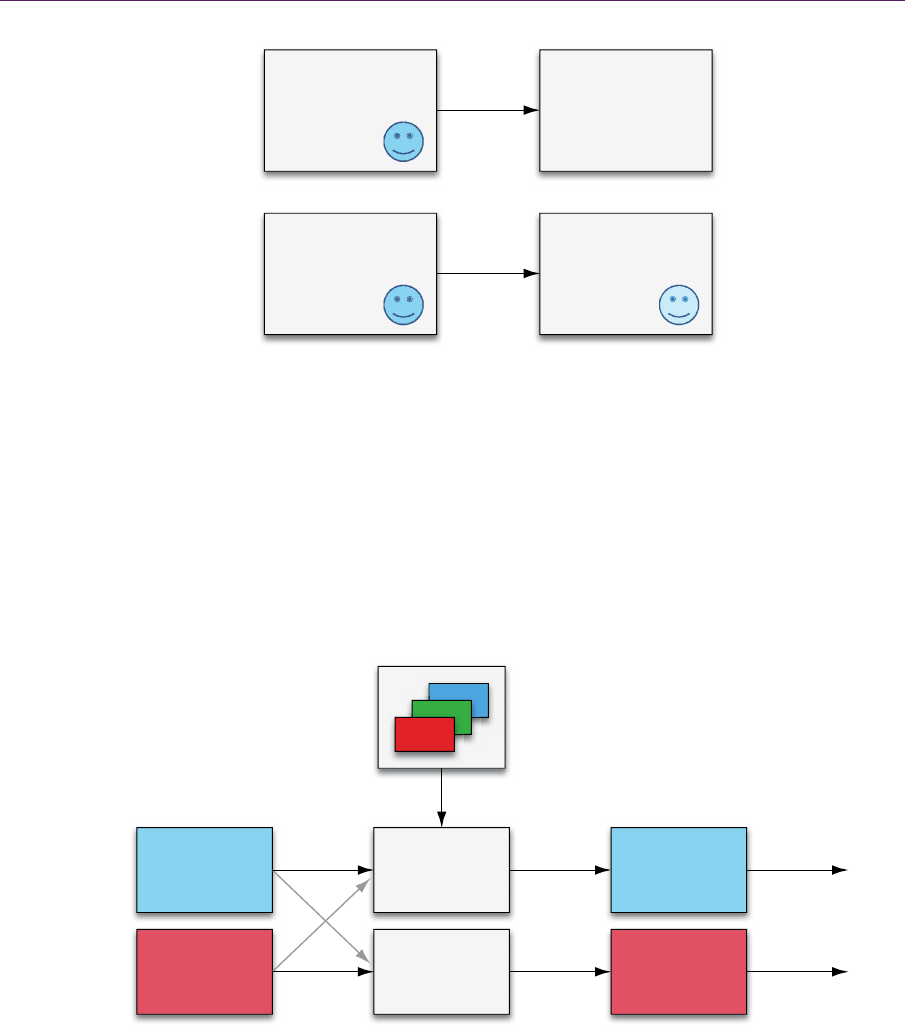
11.8SupportingBothMonoscopicandStereoscopicVersions 173
m
ax ,
x
RxR y z
Nx N x e Ny Nz
.
This means that in the worst case, it takes
4
41 1multiplication addition maximum comparison
operations. For checking the back-facing triangle for both views, the efficiency
of this test is improved by around 33 percent.
11.8SupportingBothMonoscopicand
StereoscopicVersions
If a game supports both stereoscopic and monoscopic rendering, the stereoscopic
version may have to reduce the scene complexity by having more aggressive lev-
el of detail (geometry, assets, shaders) and possibly some small objects or post-
processing effects disabled. Thankfully, the human visual system does not only
use the differences between what it sees in each eye to judge depth, it also uses
the similarities to improve the resolution. In other words, reducing the game vid-
eo resolution in stereoscopic games has less of an impact than with monoscopic
games, as long as the texture and antialiasing filters are kept optimal.
In this chapter, we focus on creating 3D scenes by using distinct cameras. It
is also possible to reconstruct the 3D scene using a single camera and generate
the parallax from the depth map and color separation, which can be performed
very efficiently on modern GPUs
1
[Carucci and Schobel 2010]. The stereoscopic
image can be created by rendering an image from one view-projection matrix,
which can then be projected pixel by pixel to a second view-projection matrix
using both the depth map and color information generated by the single view.
One of the motivations behind this approach is to keep the impact of stereoscopic
rendering as low as possible to avoid compromises in terms of resolution, details,
or frame rate.
11.9VisualQuality
Some of the techniques used in monoscopic games to improve run-time perfor-
mance, such as view-dependent billboards, might not work very well for close
objects, as the left and right quads would face their own cameras at different an-
gles. It is also important to avoid scintillating pixels as much as possible. There-
1
For example, see http://www.trioviz.com/.

174 11.Making3DStereoscopicGames
fore, keeping good texture filtering and antialiasing ensures a good correlation
between both images by reducing the difference of the pixel intensities. The hu-
man visual system extracts depth information by interpreting 3D clues from a 2D
picture, such as a difference in contrast. This means that large untextured areas
lack such information, and a sky filled with many clouds produces a better result
than a uniform blue sky, for instance. Moreover, and this is more of an issue with
active shutter glasses, a large localized contrast is likely to produce ghosting in
the image (crosstalk).
StereoCoherence
Both images need to be coherent in order to avoid side effects. For instance, if
both images have a different contrast, which can happen with postprocessing ef-
fects such as tone mapping, then there is a risk of producing the Pulfrich effect.
This phenomenon is due to the signal for the darker image being received later by
the brain than for the brighter image, and the difference in timing creates a paral-
lax that introduces a depth component. Figure 11.10 illustrates this behavior with
a circle rotating at the screen distance and one eye looking through filter (such as
sun-glasses). Here, the eye that looks through the filter receives the image with a
slight delay, leading to the impression that the circle rotates around the up axis.
Other effects, such as view-dependent reflections, can also alter the stereo
coherence.
Figure 11.10. The Pulfrich effect.
L
R
L
R
11.9VisualQuality 175
FastAction
The brain needs some time to accommodate the stereoscopic viewing in order to
register the effect. As a result, very fast-moving objects might be difficult to in-
terpret and can cause discomfort to the user.
3DSlider
Using a 3D slider allows the user to reduce the stereoscopic effect to a comforta-
ble level. The slider controls the camera properties for interaxial distance and
convergence. For instance, reducing the interaxial distance makes foreground
objects move further away, toward the comfortable area (see Figure 11.4), while
reducing the convergence moves the objects closer. The user might adjust it to
accommodate the screen size, the distance he is sitting from the screen, or just for
personal tastes.
ColorEnhancement
With active shutter glasses, the complete image is generally darkened due to the
LCD brightness level available on current 3D glasses. It is possible to minimize
this problem by implementing a fullscreen postprocessing pass that increases the
quality, but it has to be handled with care because the increased contrast can in-
crease the crosstalk between both images.
CrosstalkReduction
Crosstalk is a side effect where the left and right image channels leak into each
other, as shown in Figure 11.11. Some techniques can be applied to reduce this
problem by analyzing the color intensity for each image and subtracting them
from the frame buffer before sending the picture to the screen. This is done by
creating calibration matrices that can be used to correct the picture. The concept
consists of fetching the left and right scenes in order to extract the desired and
unintended color intensities so that we can counterbalance the expected intensity
leakage, as shown in Figure 11.12. This can be implemented using multiple ren-
der targets during a fullscreen postprocessing pass. This usually produces good
results, but unfortunately, there is a need to have specific matrices tuned to each
display, making it difficult to implement on a wide range of devices.

176 11.Making3DStereoscopicGames
Figure 11.11. Intensity leakage, where a remnant from the left image is visible in the
right view.
Figure 11.12. Crosstalk reduction using a set of calibration matrices.
Left Right
Left Right
No
crosstalk
Intensity
leakage
Left scene
texture
Right scene
texture
Crosstalk
reduction L-R
Crosstalk
reduction R-L
Corrected
left scene
Corrected
right scene
R
G
B
Input texture Frame buffer
Calibration texture
Display L
Display R
desired
I
desired
I
unintended
I

11.10GoingOneStepFurther 177
Figure 11.13. Ortho-stereo viewing with head-tracked VR.
11.10GoingOneStepFurther
Many game devices now offer support for a front-facing camera. These open new
possibilities through face tracking, where “ortho-stereo” viewing with head-
tracked virtual reality (VR) can be produced, as shown in Figure 11.13. This pro-
vides the ability to follow the user so that we can adapt the 3D scene based on his
current location. We can also consider retargeting stereoscopic 3D by adopting a
nonlinear disparity mapping based on visual importance of scene elements [Lang
et al. 2010]. In games, elements such as the main character could be provided to
the system to improve the overall experience. The idea is to improve the 3D ex-
perience by ensuring that areas where the user is likely to focus are in the com-
fortable area and also to avoid divergence on far away objects. For instance, it is
possible to fix the depth for some objects or to apply depth of field for objects
outside the convergence zone.
11.11Conclusion
Converting from a monoscopic game to stereoscopic 3D requires less than twice
the amount of processing but requires some optimization for the additional ren-
dering overhead. However, the runtime performance is only one component with-
in a stereoscopic 3D game, and more effort is needed to ensure the experience is
comfortable to watch. A direct port of a monoscopic game might not create the
best experience, and ideally, a stereoscopic version would be conceived in the
early stages of development.
Asymmetric
field of view
Dynamic
view frustum
V
iewer
Scree
n
..................Content has been hidden....................
You can't read the all page of ebook, please click here login for view all page.
